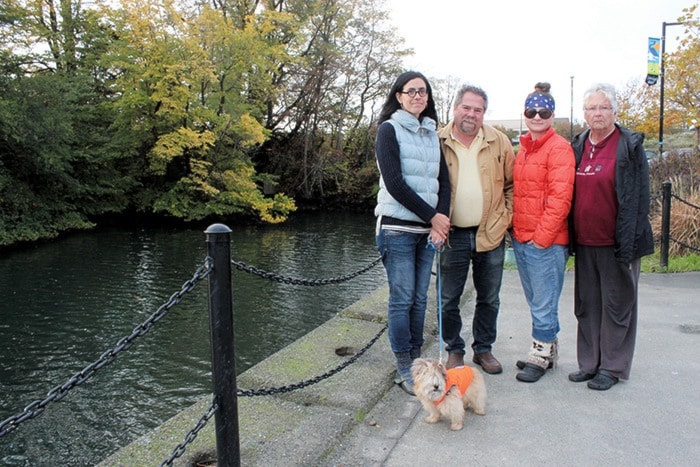Gazing out of her float home at Fisherman’s Wharf, Kristin Stein often sees an abundance of wildlife making themselves at home at Heron Cove.
On some days, Stein will see otters feasting on food on the rocks when the tide is low in the afternoon. On other days, she’ll see birds such as great blue herons, brown pelicans and swans. She also sees artists who set up easels and paint pictures of the cove, and kayakers, who stop to admire the wildlife.
Stein describes the cove as a gorgeous gem in the middle of chaos — a lot of greenery in the midst of construction and hundreds of tourists and residents that walk around the area next to Fisherman’s Wharf year-round.
“What Heron Cove offers is a quiet, contemplative place to enjoy the little bit of nature that’s left, the little bit of sanctuary that is left in this urban environment,” said Stein, who has lived in the wharf’s float home community for more than 10 years.
“There’s a lot of hustle and bustle, but when you come to the cove there’s so much life going on.”
However, Stein and other float home residents believe the ecosystem and animals at Heron’s Cove could be put in danger with the City of Victoria’s plan to build a pedestrian bridge across the cove.
As part of the plan to make upgrades to the David Foster Harbour Pathway, two pedestrian bridges will be constructed next year — one at Raymur Point, between the WorldMark property on Kingston Street towards Laurel Point, which will be 49 metres long, and the other at Heron Cove at 39 metres long, stretching from the WorldMark property to Fisherman’s Wharf.
Bridge designs are currently moving ahead and council has decided to construct two concrete box girder bridges, which have lower profile designs overall, meaning they’ll be closer to the water and will be supported by a mid-span pier that sits halfway along the bridge’s length.
In the past, Heron Cove offered a place for boats to dock for minor repairs and cleanings. However, in recent years the cove has undergone restoration with the city putting in a natural rain garden at Fisherman’s Wharf Park and banning boats from scraping contaminants into the water.
But now, residents fear the bridge will have environmental impacts on the area, and could undo all the work that has been done to restore it back to its former glory.
“We’re really trying to help the city be better informed of the process as they go forward because they’re making some really important decisions for the future of a really unique, special place that needs protection,” said Stein, adding residents are not opposed to the project, but are pushing for an environmental assessment to be completed to determine the affects the bridge could have on the ecosystem.
“A concrete bridge that does not allow natural sunlight to the seabed will kill all of the life in the path of that shadow . . . We want to work towards the evolution of Fisherman’s Wharf in that area, but we need balance.”
David Leff, chair of the Fisherman’s Wharf Community Association whose float home overlooks Heron’s Cove, said the area has become a success story when it comes to habitat restoration — one that should be cherished, not destroyed.
“It makes sense to create that special space for the observation of our natural ecological area. I think there’s an opportunity to live in harmony and use (the cove) in a positive way instead of negating our natural environment for the benefit of people touching water,” he said.
Fraser Work, director of engineering and public works with the city, said the project is not subject to the provincial and federal environment assessment acts, but that they do need permits from Transport Canada and the Department of Fisheries and Oceans, which require a certain amount of environmental questions to be asked.
“We’re working with the residents to try and find out what their concerns are to make sure that we could potentially even go a step further and see what we can do in the surrounding area to minimize design impacts both on the land side as well as on the bridge design,” he said, adding the project is still on track to be complete in the first half of 2017.
“(We’re) working with consultants, environmental and marine biologists, and ecologists to make sure that we both exceed the letter of the law as well as address each particular concern.”
